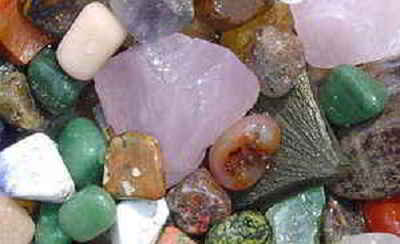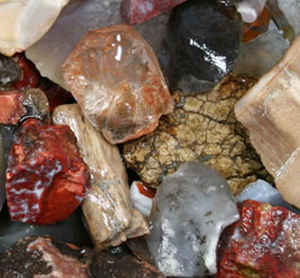Alabama Symbols
Alabama State Rock
Marble

Adopted on September 12, 1969..
Marble, calcium carbonate formation, was adopted as the official state rock of Alabama by legislative Act No. 755 on September 12, 1969.
t is a hard, high break-resistance rock, which is more attractive polished than not. Marble is mostly found in the middle eastern and the southeastern parts of Alabama. The state's marble has been used in many construction projects in the United States
Alabama State Rock: Marble

Sylacauga marble, also commonly known as Alabama marble, is a marble that is found in a belt running through Talladega County, Alabama. It is prized for its pure white color and its crystalline structure. The stone is named after the town of Sylacauga, Alabama, which is sometimes called "the Marble City". Sylacauga marble has been called the "world's whitest". in 1814, it has been mined for over 160 years, and is used for building, sculpture, and industry.
Marble is a non-foliated metamorphic rock composed of recrystallized carbonate minerals, most commonly calcite or dolomite. Geologists use the term "marble" to refer to metamorphosed limestone; however, stonemasons use the term more broadly to encompass unmetamorphosed limestone.
Physical Properties and Uses of Marble
Marble, formed from limestone with heat and pressure over years in the earth's crust. These pressure or forces cause the limestone to change in texture and makeup. The process is called recrystallization. Fossilized materials in the limestone, along with its original carbonate minerals, recrystallize and form large, coarse grains of calcite.
Marble occurs in large deposits that can be hundreds of feet thick and geographically extensive. This allows it to be economically mined on a large
scale with some mines and quarries producing millions of tons per year.
 Marble is commonly used for sculpture and as a building
material. Marble may be white, pink, gray, red, or black in color, depending on the impurities in the original limestone or dolomite. In Alabama the
major source of marble is in Talladega County, where it occurs in a narrow outcrop belt from the Coosa River to southeast of Talladega. This area is
known as the Sylacauga marble belt. Marble in the Sylacauga area is known for its high-grade crystalline texture, whiteness, and beauty. Marble from
Sylacauga has been quarried, cut, and polished for over 160 years for use as monument stone and building stone throughout the state and the country.
The Sylacauga marble has been used in numerous works of fine art, many of which can be seen in the Alabama Department of Archives and History in Montgomery
and the Birmingham Museum of Art. Sylacauga marble is now marketed primarily as a filler, agricultural soil conditioner, and micronized marble which
is shipped as a slurry for use in paper pigment and coating. Since 1900 approximately 30 million tons of marble have been quarried in Sylacauga
Marble is commonly used for sculpture and as a building
material. Marble may be white, pink, gray, red, or black in color, depending on the impurities in the original limestone or dolomite. In Alabama the
major source of marble is in Talladega County, where it occurs in a narrow outcrop belt from the Coosa River to southeast of Talladega. This area is
known as the Sylacauga marble belt. Marble in the Sylacauga area is known for its high-grade crystalline texture, whiteness, and beauty. Marble from
Sylacauga has been quarried, cut, and polished for over 160 years for use as monument stone and building stone throughout the state and the country.
The Sylacauga marble has been used in numerous works of fine art, many of which can be seen in the Alabama Department of Archives and History in Montgomery
and the Birmingham Museum of Art. Sylacauga marble is now marketed primarily as a filler, agricultural soil conditioner, and micronized marble which
is shipped as a slurry for use in paper pigment and coating. Since 1900 approximately 30 million tons of marble have been quarried in Sylacauga
- Color: Marble is usually a light-colored rock. When it is formed from a limestone with very few impurities it will be white in
color. Marble that contains impurities such as clay minerals, iron oxides or bituminous material can be bluish, gray, pink, yellow or black in color.
Marble of extremely high purity with a bright white color is very useful. It is often mined, crushed to a powder and then processed to remove as many impurities as possible. The resulting product is called "whiting". This powder is used as a coloring agent and filler in paint, whitewash, putty, plastic, grout, cosmetics, paper and other manufactured products. - Acid Reaction: Being composed of calcium carbonate, marble will react in contact with many acids, neutralizing the acid. It is
one of the most effective acid neutralization materials. Marble is often crushed and used for acid neutralization in streams, lakes and soils.
It is used for acid neutralization in the chemical industry. A pharmaceutical product known as "Tums" is a small calcium carbonate pill, sometimes made from powdered marble, that is used by people who suffer from acid reflux or acid indigestion. Powdered marble is used as an inert filler in other pills. - Hardness: Being composed of calcite, marble has a hardness of three on the Mohs hardness scale. As a result, marble is easy to
carve and that makes it useful for producing sculptures and ornamental objects. The translucence of marble makes it especially attractive for many
types of sculptures.
The low hardness and solubility of marble allows it to be used as a calcium additive in animal feeds. Calcium additives are especially important for dairy cows and egg-producing chickens. It is also used as a low hardness abrasive for scrubbing bathroom and kitchen fixtures. - Ability to Accept a Polish: After being sanded with progressively finer abrasives, marble can be polished to a high luster. This allows attractive pieces of marble to be cut, polished and used as floor tiles, architectural panels, facing stone, window sills, stair treads, columns and many other pieces of decorative stone
- Location: Marble is plentiful in the Alabama counties of Talladega, Bibb, Calhoun, Clay, Coosa, Etowah, Lee, Macon, St. Clair, and Shelby. One site in Talladega county is 200 feet thick. Much of the state's marble has been used in buildings all over the United States. Crushed marble also is used for textiles, paints, electrical insulation and plastics.
Marble became the state rock after the legislature passed Act no.755 in 1969.
Alabama Law
The law designating marble as the official Alabama state rock is found in the Code of Alabama, Title 1, Chapter 2 Section 1-2-14
Title 1 - GENERAL PROVISIONS.
Chapter 2 - STATE SYMBOLS AND HONORS.
Section 1-2-14 - Official rock.
Universal Citation: AL Code § 1-2-14 (2013)
Section 1-2-14
Official rock.
Marble is hereby designated and named the official rock of Alabama.
(Acts 1969, No. 755, p. 1334.)
Minerals, & Gems

Gemstone, Minerals, Rocks







